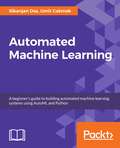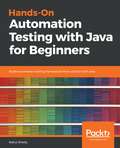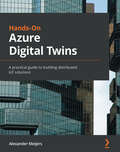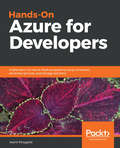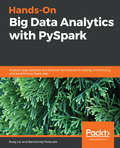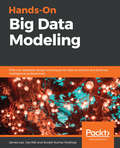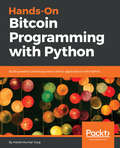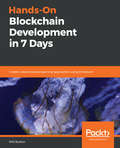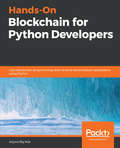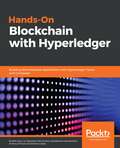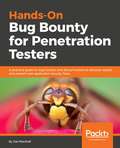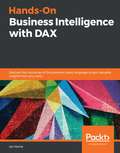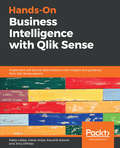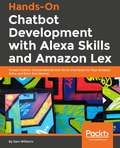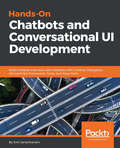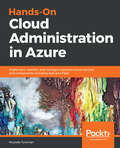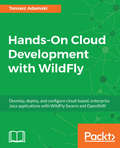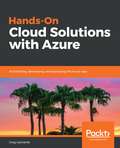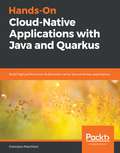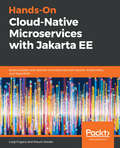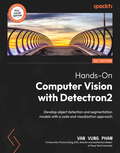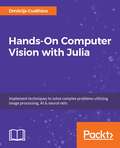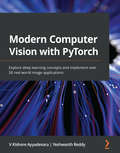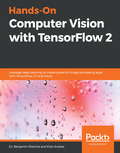- Table View
- List View
Hands-On Automated Machine Learning: A beginner's guide to building automated machine learning systems using AutoML and Python
by Sibanjan Das Umit Mert CakmakAutomate data and model pipelines for faster machine learning applicationsKey FeaturesBuild automated modules for different machine learning componentsUnderstand each component of a machine learning pipeline in depthLearn to use different open source AutoML and feature engineering platformsBook DescriptionAutoML is designed to automate parts of Machine Learning. Readily available AutoML tools are making data science practitioners’ work easy and are received well in the advanced analytics community. Automated Machine Learning covers the necessary foundation needed to create automated machine learning modules and helps you get up to speed with them in the most practical way possible. In this book, you’ll learn how to automate different tasks in the machine learning pipeline such as data preprocessing, feature selection, model training, model optimization, and much more. In addition to this, it demonstrates how you can use the available automation libraries, such as auto-sklearn and MLBox, and create and extend your own custom AutoML components for Machine Learning. By the end of this book, you will have a clearer understanding of the different aspects of automated Machine Learning, and you’ll be able to incorporate automation tasks using practical datasets. You can leverage your learning from this book to implement Machine Learning in your projects and get a step closer to winning various machine learning competitions.What you will learnUnderstand the fundamentals of Automated Machine Learning systemsExplore auto-sklearn and MLBox for AutoML tasks Automate your preprocessing methods along with feature transformationEnhance feature selection and generation using the Python stackAssemble individual components of ML into a complete AutoML frameworkDemystify hyperparameter tuning to optimize your ML modelsDive into Machine Learning concepts such as neural networks and autoencoders Understand the information costs and trade-offs associated with AutoMLWho this book is forIf you’re a budding data scientist, data analyst, or Machine Learning enthusiast and are new to the concept of automated machine learning, this book is ideal for you. You’ll also find this book useful if you’re an ML engineer or data professional interested in developing quick machine learning pipelines for your projects. Prior exposure to Python programming will help you get the best out of this book.
Hands-On Automation Testing with Java for Beginners: Build automation testing frameworks from scratch with Java
by Rahul ShettyLearn Java programming concepts to design automation testing frameworksKey FeaturesLearn to use Java program logic in application testingUnderstand various test-driven development concepts with Java toolsMaster Java with lots of programming examplesBook DescriptionJava is one of the most commonly-used software languages by programmers and developers. Are you from a non-technical background and looking to master Java for your automation needs? Then Hands-On Automation Testing with Java for Beginners is for you.This book provides you with efficient techniques to effectively handle Java-related automation projects. You will learn how to handle strings and their functions in Java. As you make your way through the book, you will get to grips with classes and objects, along with their uses. In the concluding chapters, you will learn about the importance of inheritance and exceptions with practical examples. By the end of this book, you will have gained comprehensive knowledge of Java.What you will learnUnderstand the practical usage of Java conditions and loopsWrite any Java program logic with strategies, tips, and tricksLeverage advanced topics in Java collections to solve Java-related problemsUnderstand and use objects, classes, methods, and functions in JavaBuild Java automation frameworks from scratchObtain knowledge of Java object-oriented programming (OOP) concepts with practical implementationsWho this book is forHands-On Automation Testing with Java for Beginners is for software developers who want to step into the world of software quality assurance and perform automation testing using various testing frameworks. Prior experience of writing tests in Java is assumed.
Hands-On Azure Digital Twins: A practical guide to building distributed IoT solutions
by Alexander MeijersBuild your own digital twin in no time!Key FeaturesBuild and design simple to complex digital twins solutionsCreate end-to-end solutions with Azure Digital TwinsIntegrate the Azure Digital Twins service with other Azure services to provide even richer solutionsBook DescriptionIn today's world, clients are using more and more IoT sensors to monitor their business processes and assets. Think about collecting information such as pressure in an engine, the temperature, or a light switch being turned on or off in a room. The data collected can be used to create smart solutions for predicting future trends, creating simulations, and drawing insights using visualizations. This makes it beneficial for organizations to make digital twins, which are digital replicas of the real environment, to support these smart solutions. This book will help you understand the concept of digital twins and how it can be implemented using an Azure service called Azure Digital Twins. Starting with the requirements and installation of the Azure Digital Twins service, the book will explain the definition language used for modeling digital twins. From there, you'll go through each step of building digital twins using Azure Digital Twins and learn about the different SDKs and APIs and how to use them with several Azure services. Finally, you'll learn how digital twins can be used in practice with the help of several real-world scenarios.By the end of this book, you'll be confident in building and designing digital twins and integrating them with various Azure services.What you will learnUnderstand the concept and architecture of Azure Digital TwinsGet to grips with installing and configuring the service and required toolsUnderstand the Digital Twin Definition Language (DTDL) and digital twin modelsExplore the APIs and SDKs available to access the Azure Digital Twins servicesMonitor, troubleshoot, and secure digital twinsDiscover how to build, design, and integrate applications with various Azure servicesExplore real-life scenarios with Azure Digital TwinsWho this book is forThis book is for Azure developers, Azure architects, and anyone who wants to learn more about how to implement IoT solutions using Azure Digital Twins and additional Azure services. Prior experience using the Azure Portal and a clear understanding of building applications using .NET will be helpful.
Hands-On Azure Digital Twins: A practical guide to building distributed IoT solutions
by Alexander MeijersBuild your own digital twin in no time!Key FeaturesBuild and design simple to complex digital twins solutionsCreate end-to-end solutions with Azure Digital TwinsIntegrate the Azure Digital Twins service with other Azure services to provide even richer solutionsBook DescriptionIn today’s world, clients are using more and more IoT sensors to monitor their business processes and assets. Think about collecting information such as pressure in an engine, the temperature, or a light switch being turned on or off in a room. The data collected can be used to create smart solutions for predicting future trends, creating simulations, and drawing insights using visualizations. This makes it beneficial for organizations to make digital twins, which are digital replicas of the real environment, to support these smart solutions. This book will help you understand the concept of digital twins and how it can be implemented using an Azure service called Azure Digital Twins. Starting with the requirements and installation of the Azure Digital Twins service, the book will explain the definition language used for modeling digital twins. From there, you'll go through each step of building digital twins using Azure Digital Twins and learn about the different SDKs and APIs and how to use them with several Azure services. Finally, you'll learn how digital twins can be used in practice with the help of several real-world scenarios. By the end of this book, you'll be confident in building and designing digital twins and integrating them with various Azure services.What you will learnUnderstand the concept and architecture of Azure Digital TwinsGet to grips with installing and configuring the service and required toolsUnderstand the Digital Twin Definition Language (DTDL) and digital twin modelsExplore the APIs and SDKs available to access the Azure Digital Twins servicesMonitor, troubleshoot, and secure digital twinsDiscover how to build, design, and integrate applications with various Azure servicesExplore real-life scenarios with Azure Digital TwinsWho this book is forThis book is for Azure developers, Azure architects, and anyone who wants to learn more about how to implement IoT solutions using Azure Digital Twins and additional Azure services. Prior experience using the Azure Portal and a clear understanding of building applications using .NET will be helpful.
Hands-On Azure for Developers: Implement rich Azure PaaS ecosystems using containers, serverless services, and storage solutions
by Kamil MrzyglodThis book is targeted towards anyone who wants to learn about Azure services which will help them build highly scalable cloud-based applications with ease. Prior knowledge of Azure services will be an added advantage.
Hands-On Big Data Analytics with PySpark: Analyze large datasets and discover techniques for testing, immunizing, and parallelizing Spark jobs
by Rudy Lai Bartlomiej PotaczekUse PySpark to easily crush messy data at-scale and discover proven techniques to create testable, immutable, and easily parallelizable Spark jobs Key Features Work with large amounts of agile data using distributed datasets and in-memory caching Source data from all popular data hosting platforms, such as HDFS, Hive, JSON, and S3 Employ the easy-to-use PySpark API to deploy big data Analytics for production Book Description Apache Spark is an open source parallel-processing framework that has been around for quite some time now. One of the many uses of Apache Spark is for data analytics applications across clustered computers. In this book, you will not only learn how to use Spark and the Python API to create high-performance analytics with big data, but also discover techniques for testing, immunizing, and parallelizing Spark jobs. You will learn how to source data from all popular data hosting platforms, including HDFS, Hive, JSON, and S3, and deal with large datasets with PySpark to gain practical big data experience. This book will help you work on prototypes on local machines and subsequently go on to handle messy data in production and at scale. This book covers installing and setting up PySpark, RDD operations, big data cleaning and wrangling, and aggregating and summarizing data into useful reports. You will also learn how to implement some practical and proven techniques to improve certain aspects of programming and administration in Apache Spark. By the end of the book, you will be able to build big data analytical solutions using the various PySpark offerings and also optimize them effectively. What you will learn Get practical big data experience while working on messy datasets Analyze patterns with Spark SQL to improve your business intelligence Use PySpark's interactive shell to speed up development time Create highly concurrent Spark programs by leveraging immutability Discover ways to avoid the most expensive operation in the Spark API: the shuffle operation Re-design your jobs to use reduceByKey instead of groupBy Create robust processing pipelines by testing Apache Spark jobs Who this book is for This book is for developers, data scientists, business analysts, or anyone who needs to reliably analyze large amounts of large-scale, real-world data. Whether you're tasked with creating your company's business intelligence function or creating great data platforms for your machine learning models, or are looking to use code to magnify the impact of your business, this book is for you.
Hands-On Big Data Modeling: Effective database design techniques for data architects and business intelligence professionals
by James Lee Tao WeiData Modelers, Data Architects, Database administrators, ETL developers, DW/BI professionals and Software Engineers will be the relevant users who want to design sophisticated and powerful database models.
Hands-On Bitcoin Programming with Python: Build powerful online payment centric applications with Python
by Harish Kumar GargSimplified Python programming for Bitcoin and blockchainKey FeaturesBuild Bitcoin applications in Python with the help of simple examplesMine Bitcoins, program Bitcoin-enabled APIs and transaction graphs, and build trading botsAnalyze Bitcoin transactions and produce visualizations using Python data analysis toolsBook DescriptionBitcoin is a cryptocurrency that’s changing the face of online payments. Hands-On Bitcoin Programming with Python teaches you to build software applications for mining and creating Bitcoins using Python.This book starts with the basics of both Bitcoin and blockchain and gives you an overview of these inherent concepts by showing you how to build Bitcoin-driven applications with Python. Packed with clear instructions and practical examples, you will learn to understand simple Python coding examples that work with this cryptocurrency.By the end of the book, you’ll be able to mine Bitcoins, accept Bitcoin payments on the app, and work with the basics of blockchain technology to create simply distributed ledgers.What you will learnMaster the Bitcoin APIs in Python to manipulate Bitcoin from your Python appsBuild your own Bitcoin trading bots to buy Bitcoins at a lower price and sell them at a higher priceWrite scripts to process Bitcoin payments through a website or appDevelop software for Bitcoin mining to create Bitcoin currency on your own computer hardwareCreate your own keys, addresses, and wallets in Python codeWrite software to analyze Bitcoin transactions and produce reports, graphs, and other visualizationsWho this book is forHands-On Bitcoin Programming with Python consists of examples that will teach you to build your own Bitcoin application. You will learn to write scripts, build software for mining, and create Bitcoins using Python. Anyone with prior Python experience, who wants to explore Python Bitcoin programming and start building Bitcoin-driven Python apps, will find this book useful.
Hands-On Blockchain Development in 7 Days: Create a decentralized gaming application using Ethereum
by Will ButtonBuild an Ethereum gaming application from scratch in a span of seven days, by mastering smart contracts in SolidityKey FeaturesCreate a simple, functional decentralized application, on the Ethereum networkLearn fundamental blockchain programming concepts to become a blockchain developerUnderstand the development life cycle of a blockchain applicationBook DescriptionBlockchain is a revolutionary technology that is currently been used in a variety of industrial applications, such as finance, healthcare, data analytics, and much more. This book will teach you the key blockchain principles and methodologies that are required to build decentralized applications in just 7 days.This book will teach you to build an online gaming application using Ethereum. Each section will introduce fundamental blockchain programming concepts as they relate to creating an online game, followed by practical exercises that readers can implement as homework assignments. With this book, you will learn core blockchain application development skills, create smart contracts, and build user interfaces. You will not only learn how to interact with the Ethereum network, but also how to deploy your application to the Internet. This book supplies seven self-contained lessons taught in a practical, hands-on way.By the end of the book, you will be amazed at how much you have learned about the blockchain application development on the Ethereum network, in just one week!What you will learnWork with blockchain networks to create interactive applicationsLearn how to create and use variables in smart contractsUse automated tests to eliminate mistakes and errors in the codeInteract with the Ethereum network from a user interfaceBuild a user interface for smart contracts using ReactSend and receive funds in smart contracts using walletsDeploy blockchain applications on AWS Who this book is forThis book is for software engineers and IT professionals, who are eager to learn blockchain application development skills and want to master how blockchain applications are developed. This book is perfect for those with limited programming experience.
Hands-On Blockchain for Python Developers: Gain blockchain programming skills to build decentralized applications using Python
by Arjuna Sky KokImplement real-world decentralized applications using Python, Vyper, Populus, and EthereumKey FeaturesStay up-to-date with everything you need to know about the blockchain ecosystemImplement smart contracts, wallets, and decentralized applications(DApps) using Python librariesGet deeper insights into storing content in a distributed storage platformBook DescriptionBlockchain is seen as the main technological solution that works as a public ledger for all cryptocurrency transactions. This book serves as a practical guide to developing a full-fledged decentralized application with Python to interact with the various building blocks of blockchain applications.Hands-On Blockchain for Python Developers starts by demonstrating how blockchain technology and cryptocurrency hashing works. You will understand the fundamentals and benefits of smart contracts such as censorship resistance and transaction accuracy. As you steadily progress, you'll go on to build smart contracts using Vyper, which has a similar syntax to Python. This experience will further help you unravel the other benefits of smart contracts, including reliable storage and backup, and efficiency. You'll also use web3.py to interact with smart contracts and leverage the power of both the web3.py and Populus framework to build decentralized applications that offer security and seamless integration with cryptocurrencies. As you explore later chapters, you'll learn how to create your own token on top of Ethereum and build a cryptocurrency wallet graphical user interface (GUI) that can handle Ethereum and Ethereum Request for Comments (ERC-20) tokens using the PySide2 library. This will enable users to seamlessly store, send, and receive digital money. Toward the end, you'll implement InterPlanetary File System (IPFS) technology in your decentralized application to provide a peer-to-peer filesystem that can store and expose media.By the end of this book, you'll be well-versed in blockchain programming and be able to build end-to-end decentralized applications on a range of domains using Python.What you will learnUnderstand blockchain technology and what makes it an immutable databaseUse the features of web3.py API to interact with the smart contractCreate your own cryptocurrency and token in Ethereum using VyperUse IPFS features to store content on the decentralized storage platformImplement a Twitter-like decentralized application with a desktop frontendBuild decentralized applications in the shape of console, web, and desktop applicationsWho this book is forIf you are a Python developer who wants to enter the world of blockchain, Hands-On Blockchain for Python Developers is for you. The book will be your go-to guide to becoming well-versed with the blockchain ecosystem and building your own decentralized applications using Python and library support.
Hands-On Blockchain with Hyperledger: Building decentralized applications with Hyperledger Fabric and Composer
by Salman Baset Luc Desrosiers Nitin Gaur Petr Novotny Anthony O’Dowd Venkatraman RamakrishnaLeverage the power of Hyperledger Fabric to develop Blockchain-based distributed ledgers with ease Key FeaturesWrite your own chaincode/smart contracts using Golang on hyperledger networkBuild and deploy decentralized applications (DApps)Dive into real world blockchain challenges such as integration and scalabilityBook DescriptionBBlockchain and Hyperledger technologiesare hot topics today. Hyperledger Fabric and Hyperledger Composer are open source projects that help organizations create private, permissioned blockchain networks. These find application in finance, banking, supply chain, and IoT among several other sectors. This book will be an easy reference to explore and build blockchain networks using Hyperledger technologies.The book starts by outlining the evolution of blockchain, including an overview of relevant blockchain technologies. You will learn how to configure Hyperledger Fabric and become familiar with its architectural components. Using these components, you will learn to build private blockchain networks, along with the applications that connect to them. Starting from principles first, you’ll learn to design and launch a network, implement smart contracts in chaincode and much more. By the end of this book, you will be able to build and deploy your own decentralized applications, handling the key pain points encountered in the blockchain life cycle.What you will learnDiscover why blockchain is a game changer in the technology landscapeSet up blockchain networks using basic Hyperledger Fabric deploymentUnderstand the considerations for creating decentralized applicationsLearn to integrate business networks with existing systemsWrite Smart Contracts quickly with Hyperledger ComposerDesign transaction model and chaincode with GolangDeploy Composer REST Gateway to access the Composer transactionsMaintain, monitor, and govern your blockchain solutionsWho this book is forThe book benefits business leaders as it provides a comprehensive view on blockchain business models, governance structure, and business design considerations of blockchain solutions. Technology leaders stand to gain a lot from the detailed discussion around the technology landscape, technology design, and architecture considerations in the book. With model-driven application development, this guide will speed up understanding and concept development for blockchain application developers. The simple and well organized content will put novices at ease with blockchain concepts and constructs.
Hands-On Bug Hunting for Penetration Testers: A practical guide to help ethical hackers discover web application security flaws
by Joseph MarshallDetailed walkthroughs of how to discover, test, and document common web application vulnerabilities.Key FeaturesLearn how to test for common bugsDiscover tools and methods for hacking ethicallyPractice working through pentesting engagements step-by-stepBook DescriptionBug bounties have quickly become a critical part of the security economy. This book shows you how technical professionals with an interest in security can begin productively—and profitably—participating in bug bounty programs.You will learn about SQli, NoSQLi, XSS, XXE, and other forms of code injection. You’ll see how to create CSRF PoC HTML snippets, how to discover hidden content (and what to do with it once it’s found), and how to create the tools for automated pentesting workflows.Then, you’ll format all of this information within the context of a bug report that will have the greatest chance of earning you cash. With detailed walkthroughs that cover discovering, testing, and reporting vulnerabilities, this book is ideal for aspiring security professionals. You should come away from this work with the skills you need to not only find the bugs you're looking for, but also the best bug bounty programs to participate in, and how to grow your skills moving forward in freelance security research.What you will learnChoose what bug bounty programs to engage inUnderstand how to minimize your legal liability and hunt for bugs ethicallySee how to take notes that will make compiling your submission report easierKnow how to take an XSS vulnerability from discovery to verification, and report submissionAutomate CSRF PoC generation with PythonLeverage Burp Suite for CSRF detectionUse WP Scan and other tools to find vulnerabilities in WordPress, Django, and Ruby on Rails applicationsWrite your report in a way that will earn you the maximum amount of moneyWho this book is forThis book is written for developers, hobbyists, pentesters, and anyone with an interest (and a little experience) in web application security.
Hands-On Business Intelligence with DAX: Discover the intricacies of this powerful query language to gain valuable insights from your data
by Ian HorneImplement business intelligence (BI), data modeling, and data analytics within Microsoft products such as Power BI, SQL Server, and Excel Key Features Understand the ins and outs of DAX expressions and querying functions with the help of easy-to-follow examples Manipulate data of varying complexity and optimize BI workflows to extract key insights Create, monitor, and improve the performance of models by writing clean and robust DAX queries Book Description Data Analysis Expressions (DAX) is known for its ability to increase efficiency by extracting new information from data that is already present in your model. With this book, you'll learn to use DAX's functionality and flexibility in the BI and data analytics domains. You'll start by learning the basics of DAX, along with understanding the importance of good data models, and how to write efficient DAX formulas by using variables and formatting styles. You'll then explore how DAX queries work with the help of examples. The book will guide you through optimizing the BI workflow by writing powerful DAX queries. Next, you'll learn to manipulate and load data of varying complexity within Microsoft products such as Power BI, SQL Server, and Excel Power Pivot. You'll then discover how to build and extend your data models to gain additional insights, before covering progressive DAX syntax and functions to understand complex relationships in DAX. Later, you'll focus on important DAX functions, specifically those related to tables, date and time, filtering, and statistics. Finally, you'll delve into advanced topics such as how the formula and storage engines work to optimize queries. By the end of this book, you'll have gained hands-on experience in employing DAX to enhance your data models by extracting new information and gaining deeper insights. What you will learn Understand DAX, from the basics through to advanced topics, and learn to build effective data models Write and use DAX functions and expressions with the help of hands-on examples Discover how to handle errors in your DAX code, and avoid unwanted results Load data into a data model using Power BI, Excel Power Pivot, and SSAS Tabular Cover DAX functions such as date, time, and time intelligence using code examples Gain insights into data by using DAX to create new information Understand the DAX VertiPaq engine and how it can help you optimize data models Who this book is for This book is for data analysts, business analysts, BI developers, or SQL users who want to make the best use of DAX in the BI and data analytics domain with the help of examples. Some understanding of BI concepts is mandatory to fully understand the concepts covered in the book.
Hands-On Business Intelligence with Qlik Sense: Implement self-service data analytics with insights and guidance from Qlik Sense experts
by Kaushik Solanki Pablo Labbe Clever Anjos Jerry DiMasoCreate dynamic dashboards to bring interactive data visualization to your enterprise using Qlik SenseKey FeaturesImplement various Qlik Sense features to create interactive dashboardsAnalyze data easily and make business decisions faster using Qlik SensePerform self-service data analytics and geospatial analytics using an example-based approachBook DescriptionQlik Sense allows you to explore simple-to-complex data to reveal hidden insights and data relationships to make business-driven decisions.Hands-On Business Intelligence with Qlik Sense begins by helping you get to grips with underlying Qlik concepts and gives you an overview of all Qlik Sense’s features. You will learn advanced modeling techniques and learn how to analyze the data loaded using a variety of visualization objects. You’ll also be trained on how to share apps through Qlik Sense Enterprise and Qlik Sense Cloud and how to perform aggregation with AGGR. As you progress through the chapters, you’ll explore the stories feature to create data-driven presentations and update an existing story. This book will guide you through the GeoAnalytics feature with the geo-mapping object and GeoAnalytics connector. Furthermore, you’ll learn about the self-service analytics features and perform data forecasting using advanced analytics. Lastly, you’ll deploy Qlik Sense apps for mobile and tablet. By the end of this book, you will be well-equipped to run successful business intelligence applications using Qlik Sense's functionality, data modeling techniques, and visualization best practices.What you will learnDiscover how to load, reshape, and model data for analysisApply data visualization practices to create stunning dashboardsMake use of Python and R for advanced analyticsPerform geo-analysis to create visualizations using native objectsLearn how to work with AGGR and data storiesWho this book is forIf you’re a data analyst, BI developer, or interested in business intelligence and want to gain practical experience of working on Qlik Sense, this book is for you. You’ll also find it useful if you want to explore Qlik Sense’s next-generation applications for self-service business intelligence. No prior experience of working with Qlik Sense is required.
Hands-On Chatbot Development with Alexa Skills and Amazon Lex: Create custom conversational and voice interfaces for your Amazon Echo devices and web platforms
by Sam WilliamsBuild artificial intelligence (AI) powered voice and text conversational interfaces with AmazonKey FeaturesDevelop Alexa Skills to create a working voice user interface (VUI)Integrate Amazon Lex chatbots into Facebook, Slack, and text messagesLearn to use AWS Lambda, Alexa Skills Kit, and Amazon LexBook DescriptionHave you ever wondered how Alexa apps are made, how voice-enabled technologies work, or how chatbots function? And why tech giants such as Amazon and Google are investing in voice technologies? A better question is: why should I start developing on these platforms? Hands-On Chatbot Development with Alexa Skills and Amazon Lex covers all features of the Alexa Skills kit with real-world examples that help you develop skills to integrate Echo and chatbots into Facebook, Slack, and Twilio with the Amazon Lex platform.The book starts with teaching you how to set up your local environment and AWS CLI so that you can automate the process of uploading AWS Lambda from your local machine. You will then learn to develop Alexa Skills and Lex chatbots using Lambda functions to control functionality. Once you’ve come to grips with this, you will learn to create increasingly complex chatbots, integrate Amazon S3, and change the way Alexa talks to the user. In the concluding chapters, we shift our focus to Amazon Lex and messaging chatbots. We will explore Alexa, learn about DynamoDB databases, and add cards to user conversations.By the end of this book, you will have explored a full set of technologies that will enable you to create your own voice and messaging chatbots using Amazon.What you will learnCreate a development environment using Alexa Skills Kit, AWS CLI, and Node.jsBuild Alexa Skills and Lex chatbots from scratchGain access to third-party APIs from your Alexa Skills and Lex chatbotsUse AWS services such as Amazon S3 and DynamoDB to enhance the abilities of your Alexa Skills and Amazon Lex chatbotsPublish a Lex chatbot to Facebook Messenger, Twilio SMS, and SlackCreate a custom website for your Lex chatbotsDevelop your own skills for Alexa-enabled devices such as the EchoWho this book is forHands-On Chatbot Development with Alexa Skills and Amazon Lex is for developers who are interested in building conversational bots and Alexa skills with Amazon. Prior experience with JavaScript programming is required.
Hands-On Chatbots and Conversational UI Development: Build chatbots and voice user interfaces with Chatfuel, Dialogflow, Microsoft Bot Framework, Twilio, and Alexa Skills
by Phil D Hall Vamsi Venigalla Srini JanarthanamKey Features Understand the different use cases of Conversational UIs with this project-based guide Build feature-rich Chatbots and deploy them on multiple platforms Get real-world examples of voice-enabled UIs for personal and home assistance Book Description Conversation as an interface is the best way for machines to interact with us using the universally accepted human tool that is language. Chatbots and voice user interfaces are two flavors of conversational UIs. Chatbots are real-time, data-driven answer engines that talk in natural language and are context-aware. Voice user interfaces are driven by voice and can understand and respond to users using speech. This book covers both types of conversational UIs by leveraging APIs from multiple platforms. We'll take a project-based approach to understand how these UIs are built and the best use cases for deploying them. We'll start by building a simple messaging bot from the Facebook Messenger API to understand the basics of bot building. Then we move on to creating a Task model that can perform complex tasks such as ordering and planning events with the newly-acquired-by-Google Dialogflow and Microsoft Bot framework. We then turn to voice-enabled UIs that are capable of interacting with users using speech with Amazon Alexa and Google Home. By the end of the book, you will have created your own line of chatbots and voice UIs for multiple leading platforms. What you will learn Design the flow of conversation between the user and the chatbot Create Task model chatbots for implementing tasks such as ordering food Get new toolkits and services in the chatbot ecosystem Integrate third-party information APIs to build interesting chatbots Find out how to deploy chatbots on messaging platforms Build a chatbot using MS Bot Framework See how to tweet, listen to tweets, and respond using a chatbot on Twitter Publish chatbots on Google Assistant and Amazon Alexa
Hands-On Cloud Administration in Azure: Implement, monitor, and manage important Azure services and components including IaaS and PaaS
by Mustafa ToromanExplore Azure services such as networking, virtual machines, web apps, databases, cloud migration, and securityKey FeaturesUnderstand Azure services to build, deploy, and manage workloads on cloudLearn in-depth core Azure services and work through real-world scenarios and case studiesA concise and practical guide for learning cloud administration on AzureBook DescriptionAzure continues to dominate the public cloud market and grow rapidly thanks to a number of recent innovations. Azure's wide range of services and support has led to a large number of customers switching to Azure cloud.Hands-On Cloud Administration in Azure starts with the basics of Azure cloud fundamentals and key concepts of the cloud computing ecosystem and services. Then, you will gradually get acquainted with core services provided by Azure, including Azure VNet, types and assignments of IP addresses, and network security groups. You will also work on creating and administering Azure Virtual Machines, types of virtual machines (VMs), and design VM solutions based on computing workloads. As you make your way through the chapters, you will explore Azure App Service, discover how to host your web apps in Azure, and monitor and troubleshoot them. In the concluding chapters, you will learn more complex and abstract services, such as Azure Storage, Azure Backup, and Azure Site Recovery. You will also get to grips with Azure SQL Databases and the SQL on Azure VM concept.By the end of this book, you will have obtained practical experience of working with Azure services and Azure administration, along with maintaining, monitoring, and securing your Azure resources.What you will learnUnderstand the concepts of IaaS and PaaSLearn design patterns for Azure solutionsDesign data solutions in AzureExplore concepts of hybrid clouds with AzureImplement Azure Security in cloudCreate and manage Azure resources with script-based toolsWho this book is forHands-On Cloud Administration in Azure is for system administrators, cloud admins, cloud engineers, and DevOps engineers who are interested in understanding administration-related services in Azure. Prior experience of working with Azure is an added advantage.
Hands-On Cloud Development with WildFly: Develop, deploy, and configure cloud-based, enterprise Java applications with WildFly Swarm and OpenShift
by Tomasz AdamskiCreate microservices using Java EE technologies using WildFly Swarm,deploy them in the OpenShift cloud, make them resilient to network failures using Hystrix, configure continuous integration using Jenkins, and security using Keycloak.Key FeaturesCreate functional microservices with WildFly SwarmUse OpenShift to deploy your microservices in the cloudMake your application production-ready using Jenkins, Hystrix, and KeycloakBook DescriptionThe book starts by introducing you to WildFly Swarm—a tool that allows you to create runnable microservices from Java EE components. You’ll learn the basics of Swarm operation—creating microservices containing only the parts of enterprise runtime needed in a specific case. Later, you’ll learn how to configure and test those services.In order to deploy our services in the cloud, we’ll use OpenShift. You’ll get to know basic information on its architecture, features, and relationship to Docker and Kubernetes. Later, you’ll learn how to deploy and configure your services to run in the OpenShift cloud.In the last part of the book, you’ll see how to make your application production-ready. You’ll find out how to configure continuous integration for your services using Jenkins, make your application resistant to network failures using Hystrix, and how to secure them using Keycloak. By the end of the book, you’ll have a functional example application and will have practical knowledge of Java EE cloud development that can be used as a reference in your other projects.What you will learnUtilize Java EE technology to develop modern cloud-enabled applicationsEasily create microservices with WildFly Swarm using proven Java EE technologiesSee the benefits of OpenShift – easy deployment of your services, out of the box scalability and healing, and integration with Continuous Integration toolsIntegrate the sample application with Jenkins’ Continuous Integration serverUtilize Hystrix to provide resilience to your applicationProvide security to your application using KeycloakWho this book is forIf you're an experienced developer familiar with Java EE technologies and would like to learn how you can use those technologies in the cloud with WildFly and OpenShift, then this book is for you.
Hands-On Cloud Solutions with Azure: Architecting, developing, and deploying the Azure way
by Greg LeonardoDesign effective Azure architecture and transform your IT business solutionsKey FeaturesDevelop a resilient and robust cloud environmentDeploy and manage cost-effective and highly available solutions on your public cloudDesign and implement enterprise-level cloud solutionsBook DescriptionAzure provides cloud-based solutions to support your business demands. Building and running solutions on Azure will help your business maximize the return on investment and minimize the total cost of ownership.Hands-On Cloud Solutions with Azure focuses on addressing the architectural decisions that usually arise when you design or migrate a solution to Microsoft Azure. You will start by designing the building blocks of infrastructure solution on Azure, such as Azure compute, storage, and networking, followed by exploring the database options it offers. You will get to grips with designing scalable web and mobile solutions and understand where to host your Active Directory and Identity Solution. Moving on, you’ll learn how to extend DevOps to Azure.You will also beneft from some exciting services that enable extremely smooth operations and streamlined DevOps between on-premises and cloud. The book will help you to design a secure environment for your solution, on both the Cloud and hybrid. Toward the end, you’ll see how to manage and monitor cloud and hybrid solutions.By the end of this book, you will be armed with all the tools and knowledge you need to properly plan and design your solutions on Azure, whether it’s for a brand new project or migration project.What you will learnGet started with Azure by understanding tenants, subs, and resource groupsDecide whether to “lift and shift” or migrate appsPlan and architect solutions in AzureBuild ARM templates for Azure resourcesDevelop and deploy solutions in AzureUnderstand how to monitor and support your application with AzureMake your life easier with Azure best practices and tipsWho this book is forIf you’re an IT consultant, developer, or solutions architect looking to design effective solutions for your organization, this book is for you. Some knowledge of cloud computing will assist with understanding the key concepts covered in this book.
Hands-On Cloud-Native Applications with Java and Quarkus: Build high performance, Kubernetes-native Java serverless applications
by Francesco MarchioniBuild robust and reliable Java applications that works on modern infrastructure, such as containers and cloud, using the new features in Quarkus 1.0 Key Features Build apps with faster boot time and low RSS memory using the latest Quarkus 1.0 features Seamlessly integrate imperative and reactive programming models to build modern Java applications Discover effective solutions for running Java on serverless apps, microservices, containers, FaaS, and the cloud Book Description Quarkus is a new Kubernetes-native framework that allows Java developers to combine the power of containers, microservices, and cloud-native to build reliable applications. The book is a development guide that will teach you how to build Java-native applications using Quarkus and GraalVM. We start by learning about the basic concepts of a cloud-native application and its advantages over standard enterprise applications. Then we will quickly move on to application development, by installing the tooling required to build our first application on Quarkus. Next, we'll learn how to create a container-native image of our application and execute it in a Platform-as-a-Service environment such as Minishift. Later, we will build a complete real-world application that will use REST and the Contexts and Dependency injection stack with a web frontend. We will also learn how to add database persistence to our application using PostgreSQL. We will learn how to work with various APIs available to Quarkus such as Camel, Eclipse MicroProfile, and Spring DI. Towards the end, we will learn advanced development techniques such as securing applications, application configuration, and working with non-blocking programming models using Vert.x. By the end of this book, you will be proficient with all the components of Quarkus and develop-blazing fast applications leveraging modern technology infrastructure. What you will learn Build a native application using Quarkus and GraalVM Secure your applications using Elytron and the MicroProfile JWT extension Manage data persistence with Quarkus using PostgreSQL Use a non-blocking programming model with Quarkus Learn how to get Camel and Infinispan working in native mode Deploy an application in a Kubernetes-native environment using Minishift Discover Reactive Programming with Vert.x Who this book is for The book is for Java developers and software architects who are interested in learning a promising microservice architecture for building reliable and robust applications. Knowledge of Java, Spring Framework, and REST APIs is assumed.
Hands-On Cloud-Native Microservices with Jakarta EE: Build scalable and reactive microservices with Docker, Kubernetes, and OpenShift
by Luigi Fugaro Mauro VocaleDiscover how cloud-native microservice architecture helps you to build dynamically scalable applications by using the most widely used and adopted runtime environments Key Features Build robust cloud-native applications using a variety of tools Understand how to configure both Amazon Web Services (AWS) and Docker clouds for high availability Explore common design patterns used in building and deploying microservices architecture. Book Description Businesses today are evolving rapidly, and developers now face the challenge of building applications that are resilient, flexible, and native to the cloud. To achieve this, you'll need to be aware of the environment, tools, and resources that you're coding against. The book will begin by introducing you to cloud-native architecture and simplifying the major concepts. You'll learn to build microservices in Jakarta EE using MicroProfile with Thorntail and Narayana LRA. You'll then delve into cloud-native application x-rays, understanding the MicroProfile specification and the implementation/testing of microservices. As you progress further, you'll focus on continuous integration and continuous delivery, in addition to learning how to dockerize your services. You'll also cover concepts and techniques relating to security, monitoring, and troubleshooting problems that might occur with applications after you've written them. By the end of this book, you will be equipped with the skills you need to build highly resilient applications using cloud-native microservice architecture. What you will learn Integrate reactive principles in MicroProfile microservices architecture Explore the 12-factors-app paradigm and its implications Get the best out of Java versions 8 and 9 to implement a microservice based on Thorntail Understand what OpenShift is and why it is so important for an elastic architecture Build a Linux container image using Docker and scale the application using Kubernetes Implement various patterns such as, Circuit Breaker and bulkheads Get to grips with the DevOps methodology using continuous integration (CI) and continuous deployment (CD) Who this book is for This book is for developers with basic knowledge of Java EE and HTTP-based application principles who want to learn how to build, test and scale Java EE microservices. No prior experience of writing microservices in Java EE is required.
Hands-On Computer Vision with Detectron2: Develop object detection and segmentation models with a code and visualization approach
by Van Vung Pham Tommy DangExplore Detectron2 using cutting-edge models and learn all about implementing future computer vision applications in custom domainsPurchase of the print or Kindle book includes a free PDF eBookKey FeaturesLearn how to tackle common computer vision tasks in modern businesses with Detectron2Leverage Detectron2 performance tuning techniques to control the model's finest detailsDeploy Detectron2 models into production and develop Detectron2 models for mobile devicesBook DescriptionComputer vision is a crucial component of many modern businesses, including automobiles, robotics, and manufacturing, and its market is growing rapidly. This book helps you explore Detectron2, Facebook's next-gen library providing cutting-edge detection and segmentation algorithms. It's used in research and practical projects at Facebook to support computer vision tasks, and its models can be exported to TorchScript or ONNX for deployment.The book provides you with step-by-step guidance on using existing models in Detectron2 for computer vision tasks (object detection, instance segmentation, key-point detection, semantic detection, and panoptic segmentation). You'll get to grips with the theories and visualizations of Detectron2's architecture and learn how each module in Detectron2 works. As you advance, you'll build your practical skills by working on two real-life projects (preparing data, training models, fine-tuning models, and deployments) for object detection and instance segmentation tasks using Detectron2. Finally, you'll deploy Detectron2 models into production and develop Detectron2 applications for mobile devices.By the end of this deep learning book, you'll have gained sound theoretical knowledge and useful hands-on skills to help you solve advanced computer vision tasks using Detectron2.What you will learnBuild computer vision applications using existing models in Detectron2Grasp the concepts underlying Detectron2's architecture and componentsDevelop real-life projects for object detection and object segmentation using Detectron2Improve model accuracy using Detectron2's performance-tuning techniquesDeploy Detectron2 models into server environments with easeDevelop and deploy Detectron2 models into browser and mobile environmentsWho this book is forIf you are a deep learning application developer, researcher, or software developer with some prior knowledge about deep learning, this book is for you to get started and develop deep learning models for computer vision applications. Even if you are an expert in computer vision and curious about the features of Detectron2, or you would like to learn some cutting-edge deep learning design patterns, you will find this book helpful. Some HTML, Android, and C++ programming skills are advantageous if you want to deploy computer vision applications using these platforms.
Hands-On Computer Vision with Julia: Build complex applications with advanced Julia packages for image processing, neural networks, and Artificial Intelligence
by Dmitrijs CudihinsExplore the various packages in Julia that support image processing and build neural networks for video processing and object tracking.Key Features Build a full-fledged image processing application using JuliaImages Perform basic to advanced image and video stream processing with Julia's APIs Understand and optimize various features of OpenCV with easy examplesBook DescriptionHands-On Computer Vision with Julia is a thorough guide for developers who want to get started with building computer vision applications using Julia. Julia is well suited to image processing because it’s easy to use and lets you write easy-to-compile and efficient machine code..This book begins by introducing you to Julia's image processing libraries such as Images.jl and ImageCore.jl. You’ll get to grips with analyzing and transforming images using JuliaImages; some of the techniques discussed include enhancing and adjusting images. As you make your way through the chapters, you’ll learn how to classify images, cluster them, and apply neural networks to solve computer vision problems. In the concluding chapters, you will explore OpenCV applications to perform real-time computer vision analysis, for example, face detection and object tracking. You will also understand Julia's interaction with Tesseract to perform optical character recognition and build an application that brings together all the techniques we introduced previously to consolidate the concepts learned.By end of the book, you will have understood how to utilize various Julia packages and a few open source libraries such as Tesseract and OpenCV to solve computer vision problems with ease.What you will learn Analyze image metadata and identify critical data using JuliaImages Apply filters and improve image quality and color schemes Extract 2D features for image comparison using JuliaFeatures Cluster and classify images with KNN/SVM machine learning algorithms Recognize text in an image using the Tesseract library Use OpenCV to recognize specific objects or faces in images and videos Build neural network and classify images with MXNetWho this book is forHands-On Computer Vision with Julia is for Julia developers who are interested in learning how to perform image processing and want to explore the field of computer vision. Basic knowledge of Julia will help you understand the concepts more effectively.
Hands-On Computer Vision with PyTorch: Explore deep learning concepts and implement over 50 real-world image applications
by V Kishore Ayyadevara Yeshwanth ReddyThis book is for beginners to computer vision using PyTorch and intermediate-level machine learning practitioners who are looking to get well-versed with computer vision techniques using deep learning and PyTorch. Those who are just getting started with neural networks will also find this book useful. Basic knowledge of the Python programming language and machine learning is all you need to get started with this computer vision deep learning book.
Hands-On Computer Vision with TensorFlow 2: Leverage deep learning to create powerful image processing apps with TensorFlow 2.0 and Keras
by Benjamin Planche Eliot AndresA practical guide to building high performance systems for object detection, segmentation, video processing, smartphone applications, and more. This book is based on the alpha version of TensorFlow 2.Key FeaturesDiscover how to build, train, and serve your own deep neural networks with TensorFlow 2 and KerasApply modern solutions to a wide range of applications such as object detection and video analysisLearn how to run your models on mobile devices and webpages and improve their performanceBook DescriptionComputer vision solutions are becoming increasingly common, making their way in fields such as health, automobile, social media, and robotics. This book will help you explore TensorFlow 2, the brand new version of Google's open source framework for machine learning. You will understand how to benefit from using convolutional neural networks (CNNs) for visual tasks.Hands-On Computer Vision with TensorFlow 2 starts with the fundamentals of computer vision and deep learning, teaching you how to build a neural network from scratch. You will discover the features that have made TensorFlow the most widely used AI library, along with its intuitive Keras interface, and move on to building, training, and deploying CNNs efficiently. Complete with concrete code examples, the book demonstrates how to classify images with modern solutions, such as Inception and ResNet, and extract specific content using You Only Look Once (YOLO), Mask R-CNN, and U-Net. You will also build Generative Adversarial Networks (GANs) and Variational Auto-Encoders (VAEs) to create and edit images, and LSTMs to analyze videos. In the process, you will acquire advanced insights into transfer learning, data augmentation, domain adaptation, and mobile and web deployment, among other key concepts.By the end of the book, you will have both the theoretical understanding and practical skills to solve advanced computer vision problems with TensorFlow 2.0.What you will learnCreate your own neural networks from scratchClassify images with modern architectures including Inception and ResNetDetect and segment objects in images with YOLO, Mask R-CNN, and U-NetTackle problems in developing self-driving cars and facial emotion recognition systemsBoost your application’s performance with transfer learning, GANs, and domain adaptationUse recurrent neural networks for video analysisOptimize and deploy your networks on mobile devices and in the browserWho this book is forIf you’re new to deep learning and have some background in Python programming and image processing, like reading/writing image files and editing pixels, this book is for you. Even if you’re an expert curious about the new TensorFlow 2 features, you’ll find this book useful.While some theoretical explanations require knowledge in algebra and calculus, the book covers concrete examples for learners focused on practical applications such as visual recognition for self-driving cars and smartphone apps.
